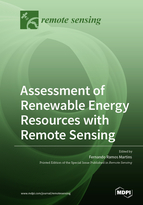Assessment of Renewable Energy Resources with Remote Sensing
A special issue of Remote Sensing (ISSN 2072-4292).
Deadline for manuscript submissions: closed (30 August 2020) | Viewed by 45131
Special Issue Editor
Interests: renewable energy assessment and forecasting; energy transition; earth system science; climate change; numerical modeling; data science
Special Issues, Collections and Topics in MDPI journals
Special Issue Information
Dear Colleagues,
The socioeconomic development of a region or country is intrinsically associated with energy consumption. We expect continuous growth in energy demand in countries with a robust emerging economy in the next decade, to support the enhancement of the quality of life and essential services such as food, health, education, transportation, and entertainment.
On the other hand, energy consumption has been pointed out as one of the factors responsible for the growing concentration of greenhouse gases (GHG) in the atmosphere due to fossil fuels being used as the primary source of energy. Concerns about climate change associated with the high GHG concentrations in the atmosphere have been driving the development of increasingly efficient technologies to exploit renewable energy resources with low GHG emissions.
However, technological developments in energy conversion processes are not a unique challenge that will boost renewable energy resources like solar energy, wind energy, hydroelectric energy, and wave energy. Reliable data and knowledge on renewable energy resource assessment are also required and essential to ensure sustainable expansion considering environmental, financial and energetic security.
Renewable energy resources have an intrinsic relationship with local atmospheric conditions and the regional climate. Even small and fast changes in meteorological conditions can cause significant variability in power generation at different time and space scales. Methodologies based on the remote sensing of the atmosphere are the primary source of information for the development of numerical models that aim at supporting the planning and operation of an electric system with a substantial contribution of intermittent energy sources.
The Special Issue focuses on disseminating scientific knowledge and technological developments for the assessment and forecasting of renewable energy resources using remote sensing techniques in order to support the expansion of the exploitation of renewable energy resources, especially in regions where energy demand is rapidly expanding.
Dr. Fernando Ramos Martins
Guest Editor
Manuscript Submission Information
Manuscripts should be submitted online at www.mdpi.com by registering and logging in to this website. Once you are registered, click here to go to the submission form. Manuscripts can be submitted until the deadline. All submissions that pass pre-check are peer-reviewed. Accepted papers will be published continuously in the journal (as soon as accepted) and will be listed together on the special issue website. Research articles, review articles as well as short communications are invited. For planned papers, a title and short abstract (about 100 words) can be sent to the Editorial Office for announcement on this website.
Submitted manuscripts should not have been published previously, nor be under consideration for publication elsewhere (except conference proceedings papers). All manuscripts are thoroughly refereed through a single-blind peer-review process. A guide for authors and other relevant information for submission of manuscripts is available on the Instructions for Authors page. Remote Sensing is an international peer-reviewed open access semimonthly journal published by MDPI.
Please visit the Instructions for Authors page before submitting a manuscript. The Article Processing Charge (APC) for publication in this open access journal is 2700 CHF (Swiss Francs). Submitted papers should be well formatted and use good English. Authors may use MDPI's English editing service prior to publication or during author revisions.
Keywords
- Renewable energy assessment and forecasting
- Remote sensing applied to the energy sector
- Climate and weather influence on renewable power resources
- Seasonal and spatial complementarity of renewable power
- Resources
- Renewable energy power plants management
- Geographical Information Systems applied to the energy sector






